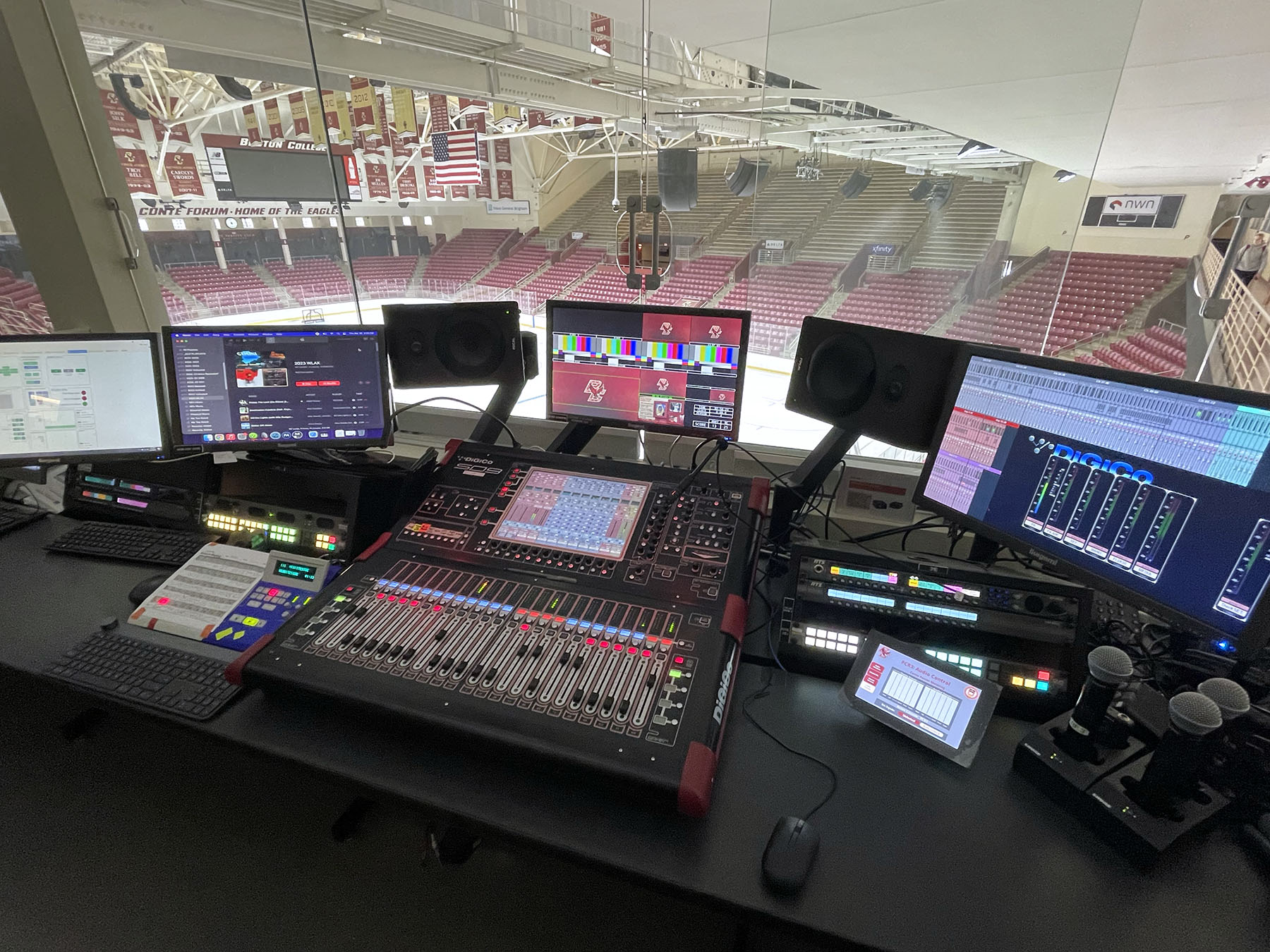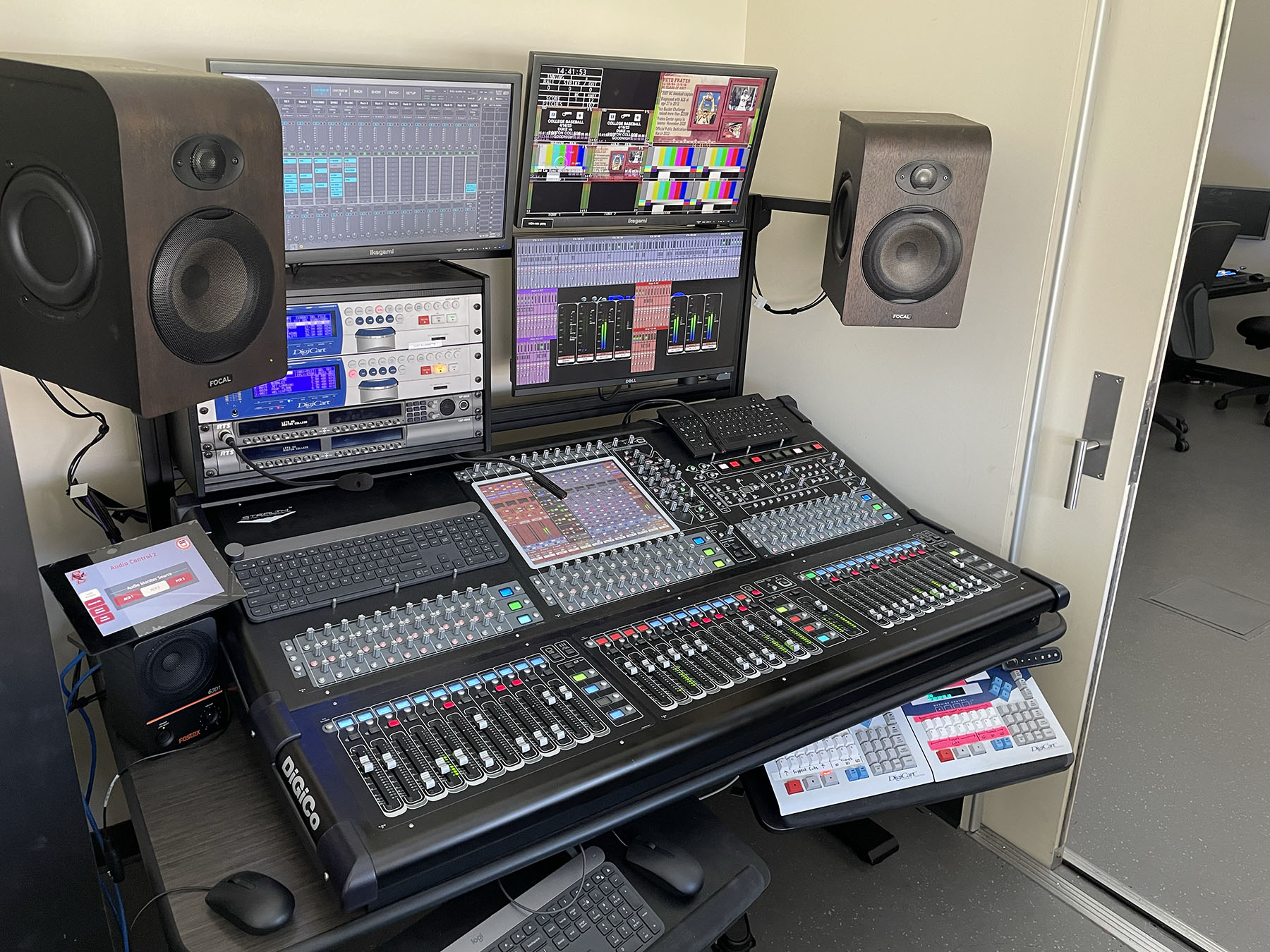Boston College Mixes Things Up for ACC Network Broadcasts
DiGiCo desks enable seamless interoperability between control rooms, venues, and the larger ACC network.

Situated in the Boston College Eagles central media suite located between the school’s 8,600-seat Conte Forum basketball/hockey arena and 44,500-seat Alumni Stadium football venue, are two new DiGiCo SD10B desks. As part of an ongoing upgrade to enhance ACC Network broadcast capabilities, the consoles replaced two earlier-installed SD9B consoles.
Founded in 2019 as part of $1 billion, 12-year media-rights deal with ESPN, the ACC Network has 11 colleges and universities carved out space in current structures, and in some cases built new ones, to create and house media facilities featuring multiple control rooms with display-covered walls and studios with green-screen backdrops. Designs varied, with the only basic collective mission requirement to ensure the ability to handle a linear broadcast.
Boston College’s technical team chose the DiGiCo desks from a very short list of consoles recommended by the ACC Network, which is partnered with broadcast-sports powerhouse ESPN. The media suite and its control rooms were designed by systems design firm Idibri, a Salas O’Brien company, and installed by systems integrator Diversified.
[UConn Gets New Stadiums and Broadcast Control Room]

Each 37-fader SD10B is the main console for each of the two matching main control rooms of the media suite. One of the earlier-installed 24-fader SD9B consoles is now located in a separate control room, locally known as “The Eagles’ Nest." This third control room is most typically used to produce the in-game experience in both venues, Alumni Stadium and Conte Forum. Here, content is produced for the Daktronics videoboards and for the PA systems, which were manufactured by local companies Fulcrum Acoustics for Alumni Stadium and Bose for Conte Forum. In addition, there are two DiGiCo MADI-equipped MQ-Racks for the SD10Bs and a D-Rack for the SD9B.
“Despite having a smaller sized audio console, this control room is almost as capable as the other two, with only a few key differences, such as the audio console is not in a separate mixing room,” said BC broadcast engineer Adam Ferguson. “The Eagles’ Nest control room can still be utilized to produce broadcasts and has actually been used to produce both the broadcast and the in-venue show simultaneously.” The remaining SD9B is used as a rolling “hot” spare as needed, he added.
The DiGiCo consoles are central to success in ACC Network broadcasts. All three desks are networked on an Optocore loop, enabling seamless interoperability between control rooms, venues, and the larger ACC network. Ferguson says “There is a considerable amount of format conversion done within the media suite’s infrastructure; for instance, the DiGiCo consoles are on a native Optocore network over single-mode fiber while the router natively uses MADI, and there are a number of Dante-enabled devices in between. That’s due to a number of factors, such as the recommendation from the ACC Network to use Evertz baseband routers, which natively use SDI and MADI.
A daily selection of features, industry news, and analysis for AV/IT professionals. Sign up below.
[You Have Got to Check Out Scoreboard 2.0 at MLB's Target Field]
“On the other hand, the convenience of Dante-enabled network audio products is something we like to take advantage of in our workflow. With Dante devices like RTS intercom belt-packs, Studio Technology announcer consoles and Shure ANI22-XLR preamps, we are able to provide all the necessary power and signal to portable devices over just one Ethernet cable. Anywhere that we can connect a device to our Dante network via Ethernet, these smart network devices will power themselves up and automatically remember all their designated routes, both inputs and outputs. This greatly simplifies our workflow, significantly decreases the number of cables we need to connect to devices that travel frequently, and it has been instrumental for extending our connectivity across several remote campuses over fiber.”

With all of the necessary conversion between MADI, Dante, and Optocore, BC also relies on DiGiCo’s Orange Boxes, which, when equipped with a DMI-Opto card, become routable I/O at all of the consoles on the Optocore loop.
After the initial ACC Network control room build-out in the summer of 2018, BC has its own network of terrestrial fiber for ACC Network Broadcast Operations, which spans several miles and connects the Alumni/Conte complex, the baseball/softball fields at the Brighton campus, the soccer and field hockey fields at the Law School campus in Newton Center, and recently, the new Connell Recreation Center, which is where volleyball and fencing coverage moved to starting this year.
“We had some flexibility when it came to choosing the audio consoles for our operation, and the SD desks were really the best choice,” he said. “We can manage multiple games and events, and interface with the rest of the ACC Network seamlessly. I was already familiar with DiGiCo’s SD9B console before this, and I knew that their flexible SD-Range consoles and their broadcast software would work perfectly for our complex demands. It was an easy decision for us to continue using DiGiCo consoles.”
That’s important, because the ACC Network today airs 450 live events annually alongside its original programming, and the event number hits 1,300 when the digital-only companion ACC Network Extra is factored in. The ACC Network control rooms at Boston College alone have produced over 120 events per year since their completion in 2018, often with multiple events and control rooms running concurrently. That requires the kind of flexible routing the SD consoles excel at.
“Our audio consoles were previously only connected via MADI ins and outs through our broadcast router,” Ferguson explained. “Now, we still have discrete MADI connections to and from the broadcast router to each console, but we also have an audio console network, which is something far more powerful. Now all of our audio operators have even more direct access to almost every audio channel in our complex system, which drastically reduces the amount of changes that need to be made from our broadcast router. This gives the audio operators a lot more flexibility to route audio and ultimately to solve problems themselves, from their audio console, where they would previously have to coordinate all routing changes with the router [broadcast] engineer.
“This is a large part of why our in-house control rooms have been such a major change to the industry, because we can produce multiple broadcasts simultaneously from our in-house control rooms and we have been able to dramatically increase the number of sports being broadcast at BC,” he continued. “This is a transformative shift that includes covering many more games that previously could not have justified the expense of a broadcast truck. Because we have permanent infrastructure in place, we can produce broadcasts for a fraction of that cost and produce a lot more games than ever before.”
The AVNetwork staff are storytellers focused on the professional audiovisual and technology industry. Their mission is to keep readers up-to-date on the latest AV/IT industry and product news, emerging trends, and inspiring installations.
